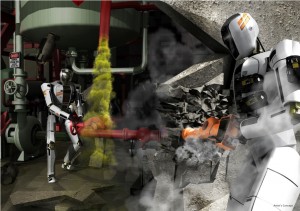
The world of Asimov’s i-Robot may be just around the corner thanks to DARPA’s new robotic challenge. Details of the Defense Advanced Research Projects Agency’s new $2 million challenge have been unveiled, revealing a highly ambitious project aimed at developing sophisticated, humanoid robots capable of doing tasks that, to date, only humans have been able to carry out. The challenge is aimed at finding humanoid robots capable of replacing soldiers and rescue workers in dangerous and hospitable locations.
DARPA intend to fund 6 hardware and 12 software teams who can produce a robot that can not only do human type tasks, but can also use tools, drive vehicles and physically traverse obstacles, which, makes it one of the most ambitious challenges DARPA have ever laid out. The developed robots would preferably need to be bipedal and be able to conduct tasks with just supervisory remote operation from humans. The purpose of the challenge is to design a robot that can replace humans in hazardous locations such as those seen in the aftermath of natural disasters, terrorist attacks or industrial accidents, like the Fukushima nuclear meltdown, where radiation made it highly dangerous for human rescue workers.
Driving
The first challenge for teams that enter the project is to develop a robot that can autonomously drive an unmodified vehicle. While the type of vehicle the robot will be expected to drive is yet to be unveiled, it is most likely going to be an ATV or heavy-duty vehicle capable of traversing rough ground. While the robot won’t have to worry about the complexities of having a valid driving license or the right HGV insurance, the robot must be capable of steering and operating the vehicle’s gas and brake pedal from the driver’s seat. In recent years, we have seen large steps taken in the development of driverless cars, but developing a robot that can actually control an unmodified vehicle is a heady challenge. While human operators may be able to provide remote assistance, the robot will still have to be designed detect and negotiate obstacles while moving the steering wheel and activating the pedals.
Driving is something many of us humans take for granted. It is quite common to drive for miles on a highway and not realize the tiny corrections in steering and adjustments to the gas pedal we are automatically doing to keep a vehicle on the road. These tasks will be made even more difficult for the robots, which are expected to drive on rugged terrain.
Walking and climbing
The next step in the DARPA challenge is a series of physical challenges for the robot. First, the robot will have to traverse uneven terrain, probably strewn with some form of debris. Walking is difficult enough for a robot and has taken many years for robotic engineers to develop machines, such as the world famous Asimo, that can replicate human movement. However, negotiating rubble and other debris will provide an added challenge, requiring the robots to have sophisticated balance systems.
The robots will also be asked to clear an obstacle from a doorway, such as a rock or cinder block, which would mean the machine would need high levels of physical strength. The next step will be for the robot to climb a ladder, which may prove the hardest aspect of the challenge because of the precise coordination the task requires.
Tool use
The final stage of the challenge is for the robot to demonstrate the ability to use human tools. This will involve a series of tasks such as unlocking a door, finding and fixing a leaky pipe or removing and replacing a pump, all of which will require the robot to have high levels of dexterity and the ability to grasp objects. Even a simple task such as using a key in a door will require an enormous amount of development to enable a robot to develop such dexterity. While we are used to industrial robots doing tasks such as welding, riveting and even screwing in parts in automotive factories, they do so with robotic attachments, to develop a robot that can actually use human tools such as a wrench will be an extreme challenge for the developers in the competition.
How close DARPA gets to its goal of getting a robot to conduct such tasks, only time will tell, but if developers can devise robots that only do a fraction of what DARPA hopes, it could create a new age in robotics and herald a new generation of ultra-sophisticated machines that would be right at home in the pages of Isaac Asimov’s most famous work.
Also see press release at:

You must be logged in to post a comment Login